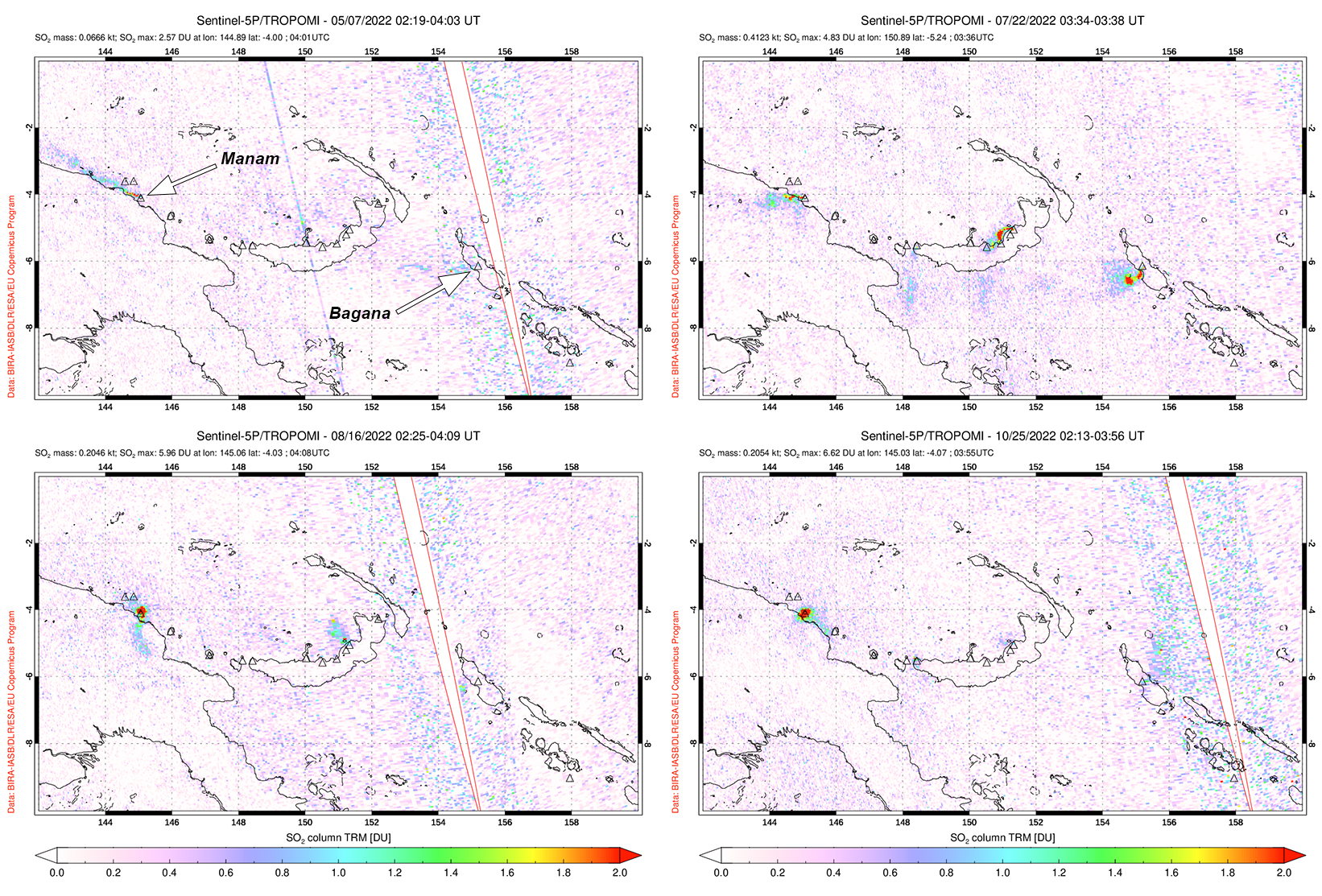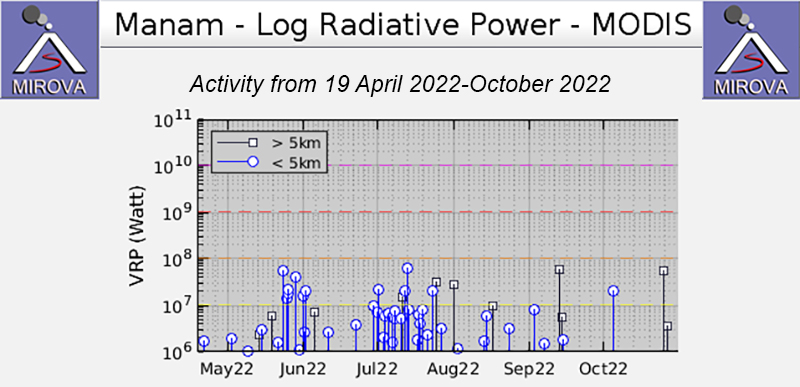Report on Manam (Papua New Guinea) — November 2022
Bulletin of the Global Volcanism Network, vol. 47, no. 11 (November 2022)
Managing Editor: Benjamin Andrews.
Edited by Kadie L. Bennis.
Manam (Papua New Guinea) Intermittent ash plumes and thermal activity during May-October 2022
Please cite this report as:
Global Volcanism Program, 2022. Report on Manam (Papua New Guinea) (Bennis, K.L., and Andrews, B., eds.). Bulletin of the Global Volcanism Network, 47:11. Smithsonian Institution.
Manam
Papua New Guinea
4.08°S, 145.037°E; summit elev. 1807 m
All times are local (unless otherwise noted)
Manam is a 10-km-wide island located 13 km off the northern coast of mainland Papua New Guinea. It consists of two active summit craters: the Main summit crater and the South summit crater, although activity is more frequently observed from the South summit crater. Frequent mild-to-moderate eruptions have been recorded since 1616. The current eruption period has been ongoing since June 2014 and has more recently been characterized by strong Strombolian explosions, ash plumes, and thermal activity (BGVN 47:08). This report covers activity during May through October 2022 using information primarily from the Darwin Volcanic Ash Advisory Center (VAAC), and various satellite data.
Intermittent ash plumes were reported by the Darwin VAAC throughout May. Continuous low-level ash plumes during 1-7 May rose to 1.8-2.7 km altitude and drifted SE, NW, ESE, and WNW, based on information from RVO, satellite images, and weather models. On 13 May an eruption was visible in satellite imagery that rose to 3.7 km altitude and drifted SW. A continuous ash plume was still visible in satellite imagery during 14-16 May at 2.4-3.7 km altitude and drifting SW and NE. During 17-19 May ash plumes rose to 2.4 km altitude and drifted NW and W, based on satellite images. Daily ash plumes were reported by the Darwin VAAC during 25-31 May that rose to 2.1-3 km altitude and drifted in different directions. An eruptive event at 0657 on 27 May generated an ash plume that rose to 2.4 km altitude, according to observations from RVO and webcam images.
Low activity was reported during June and July and mainly consisted of occasional ash plumes. During 1-3 and 5 June ash plumes rose to 2.4-3 km altitude and drifted NW, W, and SW, based on satellite and webcam images and information from RVO. On 14 July ash plumes rose to 2.1 km altitude and drifted NW. Activity during August through October was relatively quiet. On 29 October an ash plume rose to 1.5 km altitude and drifted NW; the plume dissipated within three hours.
Occasional sulfur dioxide plumes were detected using the TROPOMI instrument on the Sentinel-5P satellite, some of which exceeded at least two Dobson Units (DU) and drifted in different directions (figure 90). Intermittent low-to-moderate-power thermal anomalies were recorded during May through mid-September, as recorded by the MIROVA (Middle InfraRed Observation of Volcanic Activity) system (figure 91). Thermal activity was particularly strong during late May and early-to-mid-July. A single anomaly was detected during early October. A total of nine thermal hotspots were detected by the MODVOLC thermal alerts system on 23, 25, and 28 May, and 1, 13, 19, and 23 July. On clear weather days some of that stronger thermal activity was captured in Sentinel-2 infrared satellite imagery; the stronger hotspot was detected in the South summit crater, but occasionally, anomalies were visible in both the Main and South craters (figure 92). Distinct anomalies were detected in both the Main and South craters on 17 August, 6 September, and 1 October.
Geological Summary. The 10-km-wide island of Manam, lying 13 km off the northern coast of mainland Papua New Guinea, is one of the country's most active volcanoes. Four large radial valleys extend from the unvegetated summit of the conical basaltic-andesitic stratovolcano to its lower flanks. These valleys channel lava flows and pyroclastic avalanches that have sometimes reached the coast. Five small satellitic centers are located near the island's shoreline on the northern, southern, and western sides. Two summit craters are present; both are active, although most observed eruptions have originated from the southern crater, concentrating eruptive products during much of the past century into the SE valley. Frequent eruptions, typically of mild-to-moderate scale, have been recorded since 1616. Occasional larger eruptions have produced pyroclastic flows and lava flows that reached flat-lying coastal areas and entered the sea, sometimes impacting populated areas.
Information Contacts: Rabaul Volcano Observatory (RVO), Geohazards Management Division, Department of Mineral Policy and Geohazards Management (DMPGM), PO Box 3386, Kokopo, East New Britain Province, Papua New Guinea; Darwin Volcanic Ash Advisory Centre (VAAC), Bureau of Meteorology, Northern Territory Regional Office, PO Box 40050, Casuarina, NT 0811, Australia (URL: http://www.bom.gov.au/info/vaac/); MIROVA (Middle InfraRed Observation of Volcanic Activity), a collaborative project between the Universities of Turin and Florence (Italy) supported by the Centre for Volcanic Risk of the Italian Civil Protection Department (URL: http://www.mirovaweb.it/); Hawai'i Institute of Geophysics and Planetology (HIGP) - MODVOLC Thermal Alerts System, School of Ocean and Earth Science and Technology (SOEST), Univ. of Hawai'i, 2525 Correa Road, Honolulu, HI 96822, USA (URL: http://modis.higp.hawaii.edu/); NASA Global Sulfur Dioxide Monitoring Page, Atmospheric Chemistry and Dynamics Laboratory, NASA Goddard Space Flight Center (NASA/GSFC), 8800 Greenbelt Road, Goddard, Maryland, USA (URL: https://so2.gsfc.nasa.gov/); Sentinel Hub Playground (URL: https://www.sentinel-hub.com/explore/sentinel-playground).




